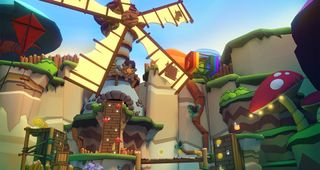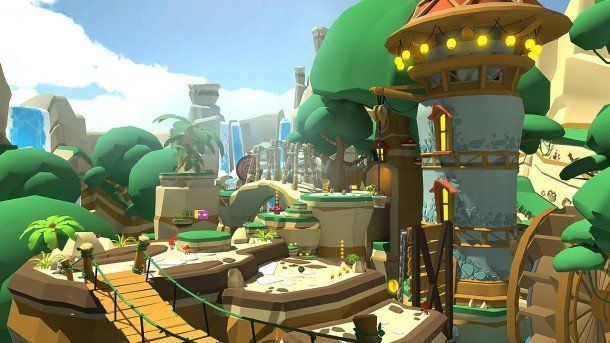Lucky is not a new Mario. He’s not Banjo, Sonic, or any of the other beloved anthropomorphised furbags many of us remember as pioneers of platforming. He’s adorable and entertaining, well-designed to be the mascot of an Oculus Rift launch game, but lacks a distinct personality, instead relying on cliches that keep him from truly standing on his own as a character who can come to symbolize a new platform. And like the bouncy fox himself, Lucky’s Tale evokes fond memories of the great 3D platformers that define the genre, but feels somewhat half-baked—introducing you to an assortment of fun enemies and obstacles, but then reusing them for the short duration of the game.
A platformer’s controls are crucial, and although I did have some difficulty trying to jump onto small objects like fence posts, developer Playful Corp has done a great job at making Lucky control smoothly. Coins and gems are scattered around every level, enticing you through the vibrant environments—each with charming sound and music design that is clearly a love letter to old Rare games. I jumped on enemies’ heads, navigated shifting platforms, cursed every time I fell short of a landing, and watched my score counter satisfyingly tick upwards with each collectible.
Lucky’s Tale has the unique privilege of also being the first platformer in modern VR, and it utilizes the new tech well. Looking down on Lucky made it feel like the game was taking place on my desk, which I wouldn’t exactly call immersive, but it was definitely the coolest way I’ve ever played a platformer—giving me a helpful 3D perspective for every jump. And while linear platformers like this are always pushing you forward, VR gave me the ability to look back. Lucky’s Tale’s level layouts cleverly play with verticality, so guiding Lucky to the top of a windmill meant I could turn around and proudly gaze over my progress from a perspective I’ve never seen before in a game like this. There’s the occasional gimmicky fish thrown directly at your face too, but Playful generally uses the VR medium effectively.

It’s tempting to ask if Lucky’s Tale could just as well have been a non-VR game. Maybe, but exactly how much it would lose in translation is up to speculation. That’s how we feel about it, despite any quibbles we may have with this first generation of hardware. If you’re new to VR, check out our set-up guide to prepare your space for the most comfort, and be sure not to push yourself too hard. (Take lots of breaks!) If you haven’t taken the headset ownership plunge, keep checking our hardware section for more on the Oculus Rift and HTC Vive hardware itself—we’ll continue to assess the two major headsets all year and beyond.
But the pressure of VR can be felt all throughout the game’s design, as the perspective in Lucky’s Tale rarely rotates or moves side-to-side. The level layouts don’t vary substantially. Only one level has any sort of unique mechanics to it—an underwater stage which has low-gravity jumping—meaning you could pretty much swap the theme of any two levels without much impact. Bouncy mushrooms turn into bouncy clams, breakable wood boxes become stone, and metal lanterns are replaced by skull torches, but I’m still jumping forward through a similarly laid-out path whether it’s in a ruined temple or a swamp. While the last couple of levels feel slightly more distinct, with more complex moving platforms and shifting walls, they only arrive at the very end of the game.
And those birds weren’t very common, even though they were one of the only enemies that couldn’t be killed by simply jumping on their heads. Caterpillars, rock golems, killer flowers; all dealt with the exact same way. And get used to dealing with them, because the same cast of enemies is reused throughout the entire game. Why am I fighting caterpillars underwater? Why are there birds and bees in temple ruins? There are spikey fish in the underwater level, and a rarely used fire enemy in the lava areas, but these are the exceptions rather than the norm. The enemy reuse is shameless, and became genuinely disappointing when I eagerly approached the game’s midway boss only to discover it was just a gladiatorial arena full of the same enemies I’d already been fighting for two hours.
It’s clear Playful didn’t have many mechanics or enemies to work with, and the short campaign meant my experience with them didn’t entirely sour. I genuinely did have fun playing through the similarly styled levels and fighting only subtly changing enemies, but I don’t think I would have for much longer. Had Lucky’s Tale used the complexity of its later levels to set the bar for the entire game, I’d gladly be looking to play more. But the vast majority of the playable stages aren’t very challenging—a conscious decision, I imagine, to make sure anyone who purchased the Rift could enjoy the game—and I finished with nearly 30 extra lives.
Playful made the core of a great game and built a beautifully presented world around it, but then stopped…
To stretch Lucky’s Tale a bit longer, after completing each level you unlock two secondary modes for it: a time trial mode, and a mode that asks you to collect 25 red coins hidden throughout each course. I enjoyed these other ways to play, as the time trial mode adds an extra level of difficulty to stages like the bomb-target one mentioned above, now asking you to aim your shots quickly and perfectly in a previously forgiving segment. The red coin hunt was fun as well, but hampered by the inexplicable decision to remove all the checkpoints from the stage for its duration—meaning if you collected all but the last coin, then mistimed the final jump and fell into the insta-death water, you would keep all the coins you already collected but have to start from the very beginning of the level again. The time trials were naturally more challenging, but if this is Playful’s way of increasing difficulty in the red coin hunt, it’s a bad one.
Playful built the core of a great game and put a beautifully presented world around it, proving that 3D platformers can thrive in VR—but then seemed to stop, reusing enemies and level elements to a fault. I’m excited to see how other developers—like Playtonic, which is developing Yooka-Laylee—tackle 3D platformers in the nascent medium, but while Lucky’s Tale is a great game to play for anyone already sold on the Oculus Rift, it won’t sell headsets on its own.


Your Comment Here